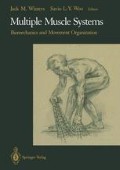Abstract
Each of the four muscles shown in Figure 36.1 (a to d) consists of muscle fascicles (bundles of muscle fibers) connected at either end to tendons, but they show striking differences of architecture. Most authors would describe (a) and (c) as pen- nate, but (b) and (d) as parallel-fibered. It often seems convenient to use these adjectives, but the distinction that they make is not a sharp one: it is easy to imagine a continuous series of intermediates between (a) and (b) or between (c) and (d). It is sometimes suggested that the diagnostic feature of a pennate muscle is that its fascicles attach obliquely to the tendons. However, the cross- sectional areas of the tendons are always much less than the total of the cross-sectional areas of the muscle fascicles, so geometry requires that the attachment be oblique even in muscles such as (b) and (d) that would generally be described as parallel-fibered. Muscle (e) has fascicles that attach at one end directly to a bone rather than to a tendon.
Access this chapter
Tax calculation will be finalised at checkout
Purchases are for personal use only
Preview
Unable to display preview. Download preview PDF.
References
Alexander, R.McN. (1974) The mechanics of jumping by a dog (Canis familiaris). J. Zool, Lond., 173: 549–573.
Alexander, R.McN. (1988) Elastic Mechanisms in Animal Movement. Cambridge University Press, Cambridge, England.
Alexander, R.McN., Jayes, A.S., Maloiy, G.M.O. and Wathuta, E.M. (1979) Allometry of the limb bones of mammals from shrews (Sorex) to elephant (Loxodonta). J. Zool, Lond., 189: 305–314.
Alexander, R.McN., Jayes, A.S., Maloiy, G.M.O. and Wathuta, E.M. (1981) Allometry of the leg muscles of mammals. J. Zool., Lond., 194: 539–552.
Alexander, R.McN. and Vemon, A. (1975a) The mechanics of hopping by kangaroos (Macropodidae). J. Zool, Lond., 177: 265–303.
Alexander, R.McN. and Vemon, A. (1975b) The dimensions of knee and ankle muscles and the forces they exert J. Human Movt. Stud., 1: 115–123.
Bennett, M.B., Ker, R.F., Dimery, N.J. and Alexander, R.McN. (1986) Mechanical properties of various mammalian tendons. J. Zool, Lond. (A), 209: 537–548.
Brown, T.I.H., Rack, P.M.H. and Ross, H.F. (1982) Forces generated at the thumb interphalangeal joint during imposed sinusoidal movements. J. Physiol, 332: 69–85.
Camp, C.L. and Smith, N. (1942) Phylogeny and functions of the digital ligaments of the horse. Mem. Univ. Calif., 13: 69–124.
Cutts, A. (1986) Sarcomere length changes in the wing muscles during the wing beat cycle of two bird species. J. Zool, Lond. (A), 209: 183–185.
Dimery, N.J. (1985) Muscle and sarcomere lengths in the hind limb of the rabbit (Oryctolagus cuniculus) during a galloping stride. J. Zool Lond. (A), 205: 373–383.
Dimery, N.J., Alexander, R.McN. and Ker, R.F. (1986) Elastic extension of leg tendons in the locomotion of horses (Equus caballus). J. Zool, Lond. (A), 210: 415–425.
Goslow, G.E., Reinking, R.M. and Stuart, D.G. (1973) The cat step cycle: hind limb joint angles and muscle lengths during unrestrained locomotion. J. Morph., 141: 1–42.
Griffiths, R.I. (1989) The mechanics of the medial gastrocnemius muscle in the freely hopping wallaby (Thylogale billardierii). J. Exp. Biol, 147: 439–456.
Heglund, N.C. and Cavagna, G.A. (1987) Mechanical work, oxygen consumption and efficiency in isolated frog and rat striated muscle. Am. J. Physiol, 253: C22–C29.
Hoffer, J.A., Caputi, A.A., Pose, I.E. and Griffiths, R.I. (1989) Roles of muscle activity and load on the relationship between muscle spindle length and whole muscle length in the freely walking cat. Progr. Brain Res. 80: 75–85.
Ker, R.F., Alexander, R.McN. and Bennett, M.B. (1988) Why are mammalian tendons so thick? J. Zool, Lond.,. 216: 309–324.
Ker, R.F., Bennett, M.B., Bibby, S.R., Kester, R.C. and Alexander, R.McN. (1987) The spring in the arch of the human foot. Nature, 325: 147–149.
Ker, R.F., Dimery, N.J. and Alexander, R.McN. (1986) The role of tendon elasticity in hopping in a wallaby (Macropus rufogriseus). J. Zool, Lond. (A), 208: 417–428.
Loeb, G.E., Pratt, C.A., Chanaud, C.M. and Richmond, F.J.R. (1987) Distribution and innervation of short, interdigitated muscle fibers in parallel-fibered muscles of the cat hindlimb. J. Morph. 191: 1–15.
Morgan, D.L., Proske, U. and Warren, D. (1978) Measurements of muscle stiffness and the mechanism of elastic storage of energy in hopping kangaroos. J. Physiol., 282: 253–261.
Poliacu Prosé, L. (1986) De functioned stabiliteit van de knie van de kat. Thesis, Free University of Brussels, Belgium.
Rack, P.M.H. and Ross, H.F. (1984) The tendon of flexor pollicis longus: its effects on the muscular control of force and position at the human thumb. J. Physiol, 351: 99–110.
Rack, P.M.H. and Westbury, D.R. (1984) Elastic properties of the cat soleus muscle and their functional importance. J. Physiol, 347: 479–495.
Rome, L.C., Funke, R.P., Alexander, R. McN., Lutz, G., Aldridge, H., Scott, F. and Freadman, M. (1988) Why animals have different muscle fiber types. Nature, 335: 824–827.
Taylor, C.R., Shkolnik, A., Dmi’el, R., Baharav, D. and Borut, A. (1974) Running in cheetahs, gazelles and goats: energy costs and limb configuration. Am. J. Physiol, 227: 848–850.
Woledge, R.C., Curtin, N.A. and Homsher, E. (1985) Energetic Aspects of Muscle Contraction. Academic Press, London.
Editor information
Editors and Affiliations
Rights and permissions
Copyright information
© 1990 Springer-Verlag, New York
About this chapter
Cite this chapter
Alexander, R.M., Ker, R.F. (1990). The Architecture of Leg Muscles. In: Winters, J.M., Woo, S.LY. (eds) Multiple Muscle Systems. Springer, New York, NY. https://doi.org/10.1007/978-1-4613-9030-5_36
Download citation
DOI: https://doi.org/10.1007/978-1-4613-9030-5_36
Publisher Name: Springer, New York, NY
Print ISBN: 978-1-4613-9032-9
Online ISBN: 978-1-4613-9030-5
eBook Packages: Springer Book Archive

